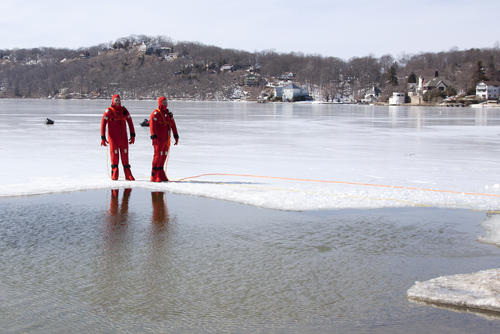The polar vortex and the Arctic blast may sound like the names of frozen treats from your local ice cream shop; sadly, you’re not likely to top off the real thing with whipped cream and colorful sprinkles. These blasts of frigid air and accompanying winter weather can do real damage—some of which might require a little first aid.

Here’s what you can do to keep workers in the game when winter injuries take their toll.
Dangerous Cold
How cold is too cold? A cold environment forces the body to work harder to maintain its temperature. Cold air, water, and snow all draw heat from the body. According to OSHA, cold stress occurs when cold conditions overcome the body’s natural ability to warm itself. Under pressure from the cold, the body will begin to shift blood from the extremities and outer skin to the core (the chest and abdomen). This allows exposed skin and the extremities to cool rapidly, leading to tissue damage and possibly death.
Four factors contribute to cold stress:
- Cold air temperatures
- High velocity air movement
- Dampness of the air
- Contact with cold water or surfaces
OSHA also points out that while below-freezing conditions and inadequate protection can bring about cold stress, problems can also occur with much higher temperatures, even in the 50s, when coupled with rain and wind.
Overlooking industrial hygiene can have a devastating impact on workers’ health and your overall safety record. Join us on Thursday, February 19, and you’ll learn the basics of industrial hygiene.
Frostbite
Frostbite occurs when the skin and tissues beneath the skin freeze. The damage is reversible if it is caught early and treated properly. If frostbite is not quickly dealt with, however, it can lead to permanent tissue damage, and even amputation.
Workers need to recognize the symptoms of frostbite, including feeling uncomfortably cold, and then feeling numb; or feeling tingling, aching, or brief pain in the affected body parts. Skin color may change dramatically: The skin will first look much paler than normal, and waxy; as frostbite progresses, skin may darken and blister, becoming an unhealthy shade of blue, gray, or black, with a “wooden” feel.
Don’t treat frostbite until the victim is out of the cold for good, so that tissue will not refreeze, and don’t treat frostbite until you have first treated any symptoms of hypothermia. Also, remember that direct application of heat can cause more damage. Here are some frostbite first aid do’s and don’ts:
- Don’t rub the affected body part.
- Don’t apply a heat lamp or hot water bottles.
- Don’t go near a hot stove.
- Don’t break blisters.
- Do warm the frozen body part quickly with sheets, blankets, or warm—not hot—water.
- Do exercise the warmed body part—but don’t walk on frostbitten feet.
- Do get medical attention.
- Do elevate the frozen body part and cover with sterile cloths before moving.
Attend this webinar and learn how to minimize industrial hygiene risks in your workplace, so you can keep employees from exposure-related injury and illness.
Hypothermia
Hypothermia occurs when body heat is lost faster than it can be replaced. Symptoms begin when the core body temperature drops from the normal 98.6°F to around 95°F.
Workers may begin to shiver and stomp the feet in order to generate heat. They may lose coordination, experience slurred speech, and fumble with items in their hands. The skin will likely be pale and cold. As the body temperature falls, symptoms will worsen and shivering will stop. At a body temperature of below 85°F, severe hypothermia will develop and the person may become unconscious; at 78°F, death can occur.
Treatment depends on the severity of the hypothermia. To treat hypothermia:
- Do call for medical help.
- Do give artificial respiration if needed.
- Do move the victim into a warm area.
- Do removed frozen, wet, or tight clothes.
- Do bundle the victim in warm clothes or blankets.
- Do give the victim something warm to drink.
- Don’t give the victim anything containing caffeine or alcohol.
Tomorrow, we’ll look at three more cold injuries you may have to deal with: trench foot, dehydration, and overexertion.
